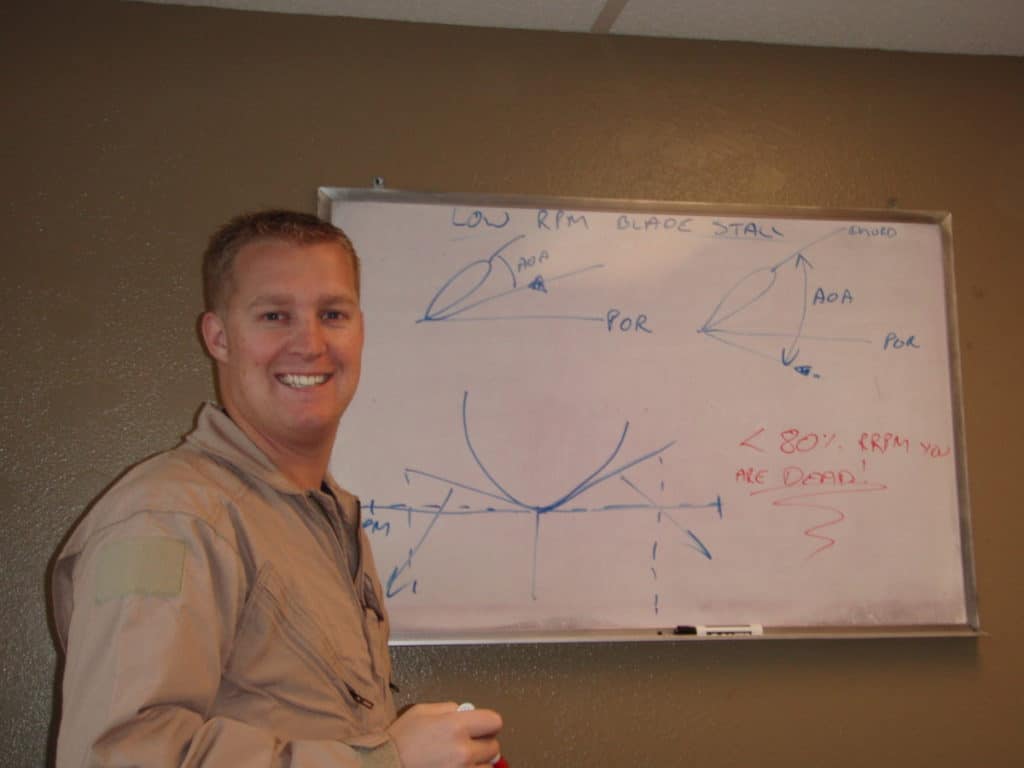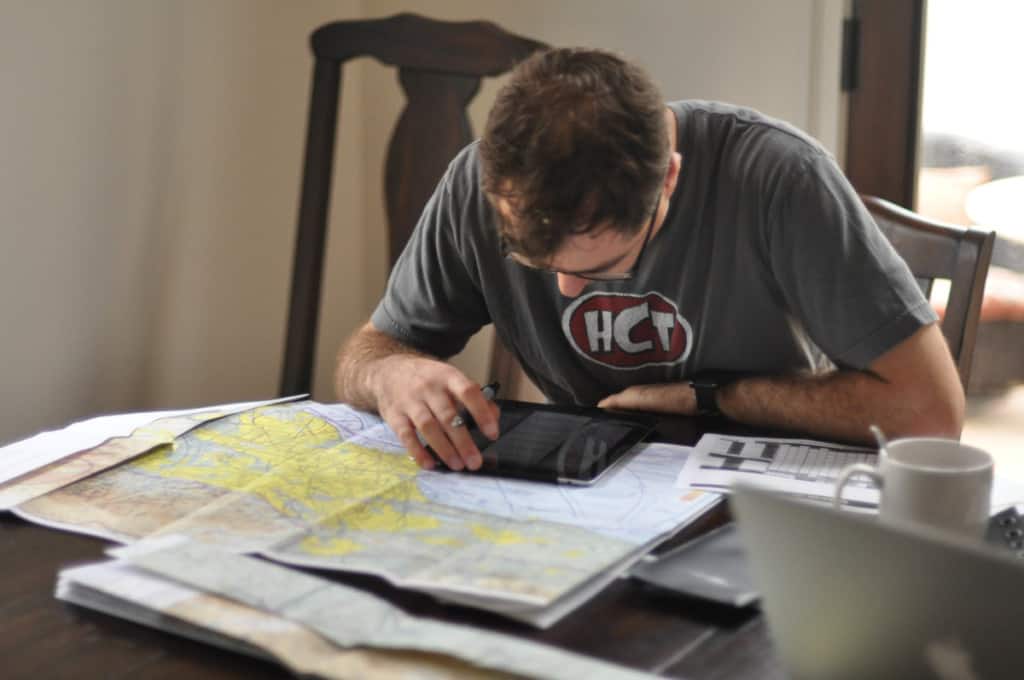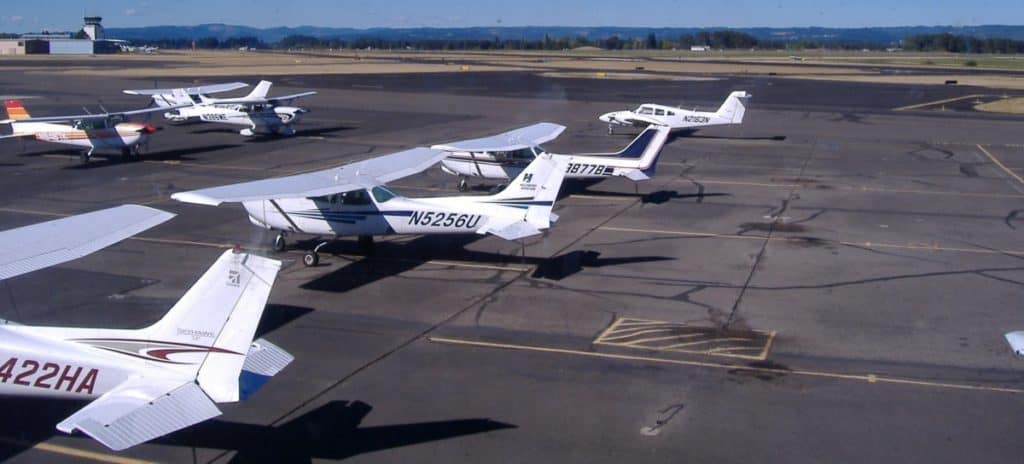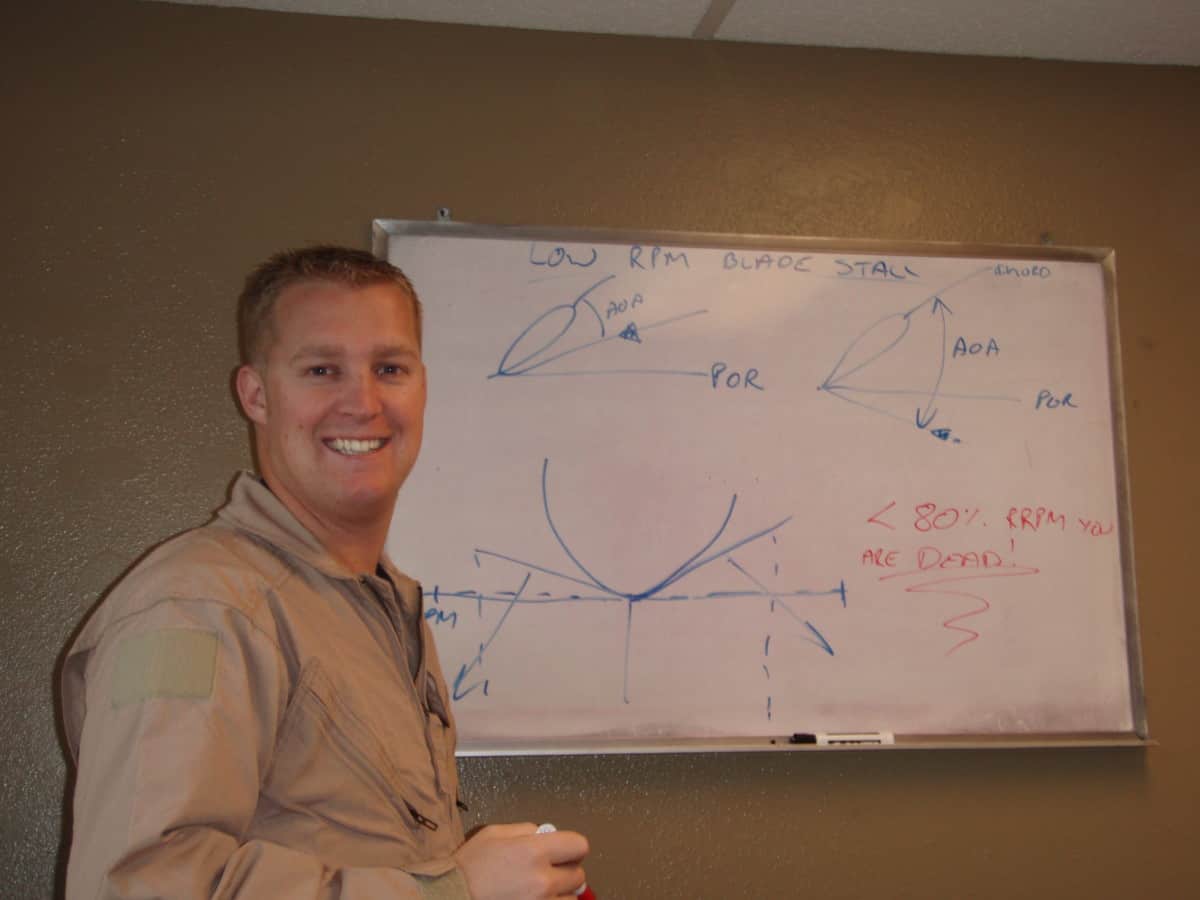
Learning to fly is a serious commitment in both money and time and learning to fly while still working may be the only option for some students, so can it be done? Surely not everyone who learns to fly has to commit to a full-time training program?
Learning to fly can be completed either part-time or full-time. Some professional pilot & degree programs require full-time study, while most pilot certificates can be obtained part-time. Training part-time will take longer & cost more as proficiency takes longer to develop with gaps between lessons.
When I was learning to fly I completed both part-time and full-time training and later, many of my students trained with a mix of both so I have the perfect insider knowledge and experience to answer this for you. The main thing you have to understand is that it is down to your own personal circumstances and the type of pilot certificate you wish to obtain.
Some flight training must be completed full-time and other training can be completed part-time so to learn more, please read on!
Can You Go To Flight School and Work Full-Time?
Some professional pilot programs & aviation degrees require full-time commitment due to the time it takes to complete. A mix of flight training & academic study covers a vast amount of material & proficiency, which can take from 1 to 4 years to complete. Part-time is impractical for these programs.
For most pilots that wish to gain a Sport, Recreational, or Private Pilot certificate the option to train part-time is the most common method. For those pilots who wish to become a professional pilot, 95% of the students I’ve trained will move into full-time training once they begin commercial pilot training, if not before.
Many students are not sure if a career in aviation is exactly what they need, so many will complete their Private Pilot Certificate during evenings, weekends, and vacation time from their full-time job. This is exactly how I began flying. My full-time employment paid for my training until I knew this was something I want to do full-time, then I made plans to leave my current job and enroll full-time into flight school beginning with the Commercial Pilot Certificate.
Training while working allows you the flexibility to stay financially stable but will require lots of study at home and sacrificing spare time to fly every chance you get.

Creating a dedicated space away from the distractions of home life and family is paramount to ensure enough, undisturbed time can be allocated to study. The amount of knowledge to be consumed, especially for the commercial certificate is monumental, and trying to do this while sitting at the kitchen table very rarely works.
By far the biggest factor in learning to fly while working full-time is that it takes significantly longer to gain your pilot certificate due to the limited amount of hours you can fly each week or month. The other element to take into account is the weather. Depending on where you live/train, the weather can easily set you back weeks if it is not cooperating when you work full-time
When I was undertaking my Private Pilot Certificate I needed good weather to allow me to complete my solo cross-country flight. It took me several weeks for the weather to be above the minimum limitations set by my school and luckily my employer was very accommodating in allowing me to leave work at a moment’s notice when the weather looked good.
Other students may not have this luxury and waiting until the right weekend weather is there can be frustrating.
Most flight schools allow the flexibility for the student to choose how often they train, but some schools may have mandatory syllabuses because of classroom-based instruction. During the flight school selection, you will have to enquire about any mandatory attendance requirements.
For students enrolled in a complete professional pilot program or a degree in aviation with flight training as part of the syllabus, then only full-time attendance is mandatory. The number of hours to be flown and the amount of knowledge to gain can be too much for a student to accomplish while working full-time.
Learn More…
Try These Articles:
* Do Flight Schools Drug Test Students & Instructors?
* U.S. Flight Training Visas: Your Easy, Helpful Guide!
* Flight School Requirements – Are There Any For Joining?
* Flight School Reputation – Does It Matter Where You Train?
How Many Days a Week is Flight School?
Full-time flight students usually aim to fly 1-2 times each day & part-time students 1-2 times per week. Larger flight schools allow a student to train every day but smaller flight schools with limited aircraft & instructor availability may limit students to only weekdays or a few days per week.
Flight school is a tiring and challenging journey and most students that are on a shorter program like a Private Pilot Certificate may train seven days a week for 4-6 weeks. Even pilots on a larger, professional pilot program may fly 7 days a week, but I can tell you that from experience most pilots who start like this burnout. When a flight school allows for 7 days a week training I find most students will train for 5-6 days per week and have some downtime.
Not only is the flight training mentally and physically challenging but the student also needs time to dedicate to the theory/ground school portion of the training to be able to pass the written knowledge exams and the ground examination during stage checks and the certificate check rides (Flight Test).

Join My Newsletter & Get Great Tips, Information and Experiences To Help You Become a Superb Pilot!
On the longer programs, most students will usually have one flight lesson and one ground lesson each day. This seems to be the perfect balance to allow all the material to be absorbed and allows for regular flying to keep their skills progressing.
Here is a typical example of calculating roughly how long it would take a student to complete a Private Pilot Certificate:
Flying 5 Days Per Week:
1.5 Hour Flight Every Morning &
1.5 Hour Flight Every Afternoon
= 3 Hours Per Day x 5 Days Per Week
= 15 Hours Per Week
Student Average Totals to Complete PPL:
50 Hours ÷ 15 Hours = 3.5 Weeks To Complete
80 Hours ÷ 15 Hours = 5.5 Weeks To Complete
Flying 7 Days Per Week:
1.5 Hour Flight Every Morning &
1.5 Hour Flight Every Afternoon
= 3 Hours Per Day x 7 Days Per Week
= 21 Hours Per Week
Student Average Totals to Complete PPL:
50 Hours ÷ 21 Hours = 2.5 Weeks To Complete
80 Hours ÷ 15 Hours = 3.5 Weeks To Complete
If you wish to know how even more about how long it takes to complete a pilot training program then please check out my article covering that aspect below. It is written for a helicopter student, but the hours for an airplane are very similar and will give you an idea of the timescale for all the pilot certificates:
How Long Does it Take to Become a Pilot?
Is Full-Time Flight Training Better Than Part-Time?
Full-time flight training is better than part-time training as it allows the student to progress faster through the training, and develop muscle memory for controlling the aircraft & immersive environments improve studying. Long breaks between flights take longer to develop the skills required for flight.
Not every student is able to learn to fly in a full-time capacity even if they wish to do so. I know I wasn’t. Personal circumstances will dictate whether that student can dedicate the time required to gain their pilot certificate and the more in-depth the training, the more benefits there are to learning to fly full-time.
There are Both Pros and Cons to Learning to Fly Full-Time:
Pro’s
- Flight training can be completed in weeks
- Skills develop faster allowing for less ‘Recap’ when in the air
- Familiarity develops muscle memory faster
- Fewer costs associated with accommodation & expenses if training away from home
- Closer bond development between student & instructor
- Reduced time to complete a program due to faster progression
- Immersive school environments help knowledge absorption
- Increased access to instructors & students for answers to questions
- Chance to fly with other instructors to help overcome plateaus
- Weather delays are not as detrimental compared to a part-time student
- Preferred training slots available to full-time students
Con’s
- May have to quit full-time employment for a large training program
- A possible large financial budget is required to be sourced
- The budget may not allow for large monthly expenses
- Risk of running out of finance if not budgeted correctly
- Time may not allow all the training to be completed in the allotted time frame
- Expenses & accommodation are required on top of training costs if away from home
- Aircraft & instructor availability may become an issue at small or busy schools
- Hard work requiring dedication & sacrifice
- Lots to learn both in flight and knowledge
- Rest time must be incorporated into training
- Risk of ‘Burn Out’ if training too much
- Wait times for exams and check rides need to be addressed early
My personal recommendation is to fly as often as you can. The more regularly you train, the faster and more efficient your training will be, which will lead to a lower cost to complete your flight training.

It took me 2.5 years to complete my Private Pilot Certificate as I was only able to fly one hour every two weeks. At that time that was the only way I could learn to fly. Because of this, it took me close to 70 hours to finish my training.
For my students who flew full time, most completed the same training in around 5-6 weeks, requiring around 50-60 hours of flight time on average. At that time, an hour in a Robinson R22 helicopter with an instructor was $240. This increased timescale cost me between $2,400 – $4,800 just because the first 1/4 of most of my lessons were spent ‘Re-capping’ what we had flown on the last flight.
Full-Time Flying Allows For Faster, More Efficient & Cheaper Training
In addition to the article mentioned above about how long it takes to complete flight training, it is important to know roughly how much it’s going to cost. To help you, I have written a full breakdown of all the pilot certificates for both airplanes and helicopters which will really help you budget for your training. You can find that article here:
Cost To Become a Pilot – All the Certificates Explained
Can You Learn To Fly Just On Weekends?
Many pilots first learn to fly just on weekends. A typical student taking 50 hours to gain their Private Pilot Certificate will take around 9 weeks to complete if flying twice each weekend day. Becoming a professional pilot usually requires full-time training due to the number of hours to be flown.
Depending on the type of interest you have in aviation will dictate how you learn to fly. For pilots who wish to purchase their own aircraft or fly for recreational purposes, most will train only at weekends as this is the only time they have free. This was true for me. Hour building at weekends is great fun and an easy way to fly regularly.
Here is an example of how long it would take an average student to complete a Private Pilot Certificate flying only on weekends:
Flying Saturday & Sunday Only:
1.5 Hour Flight Every Morning &
1.5 Hour Flight Every Afternoon
= 3 Hours Per Day x 2 Days Per Week
= 6 Hours Per Week
Flying Saturday Only:
1.5 Hour Flight Every Saturday
= 1.5 Hours Per Week
Typical Student Average Totals:
50 Hours ÷ 6 Hours = 8.5 Weeks To Complete
80 Hours ÷ 6 Hours = 13.5 Weeks To Complete
Typical Student Average Totals:
50 Hours ÷ 1.5 Hours = 33 Weeks To Complete
80 Hours ÷ 1.5 Hours = 53 Weeks To Complete
The More You Can Fly on Weekends, the Faster and Cheaper Your Training Will Be
When a student wishes to fly more for a career, at some point they will usually commit to flight training and join a full-time program. The number of hours to be flown in a Commercial Pilot Certificate can easily be done just on weekends but can take many years to amass. For some pilots, this is fine and may be their only option as they have to work to pay for their training. For those wishing to progress much faster, then full-time training is usually the way forward.
It took me 2.5 years to gain my helicopter private pilot certificate and then a further year flying at weekends while hour building before I moved to the U.S. to complete the rest of my commercial and instructor certificates, so flying at weekends is an option – It just takes longer and progression is slower due to the gaps between lessons.
To Finish
Learning to fly can easily be completed both full-time, or part-time. Every person’s situation is different and will dictate which path they take. Being able to fly often not only allows you to progress faster thus reducing costs, but it also means you are studying every night to ensure your academic side of the training does not hold you back.
Before every flight test, the student has to have passed the written knowledge exam for that certificate. For this reason, finding a balance between flying and studying is paramount to ensure there are no large gaps between flights.


